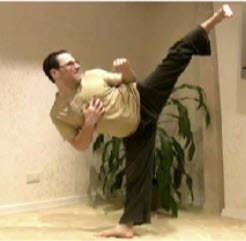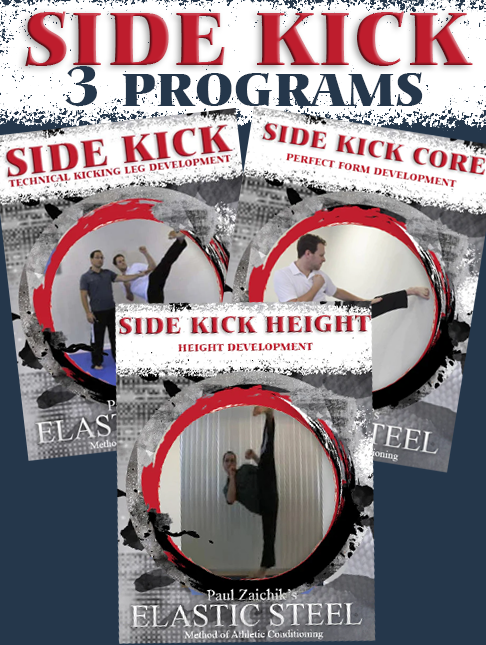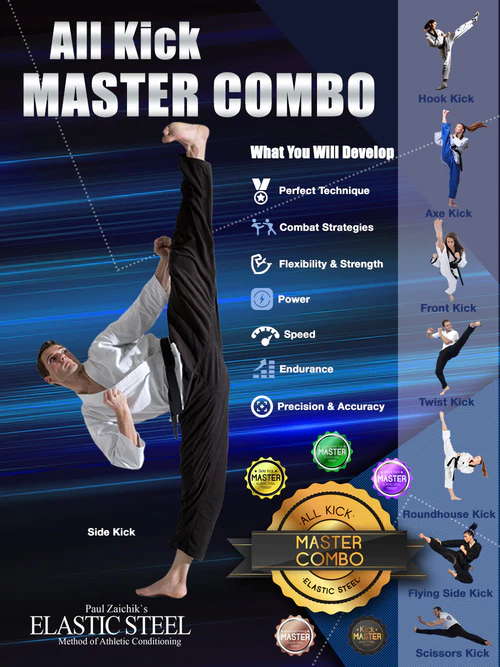Flying sidekick: 6 Common mistakes and Corrections

Flying sidekick: Common mistakes and Corrections
This article covers the common mistakes and how to correct them when performing a Flying Side Kick. When performing a Flying Sidekick there are certain mistakes that are made by beginner, intermediate and advanced students. And usually those mistakes are not the same, although sometimes there is an overlap.
Common mistake #1: Run & Jump with Both Legs
The first common mistake usually performed by beginner students when learning a
Flying Side Kick is to run and jump with both legs. This is usually due to lack of strength to jump with one leg. Or improperly taught technique.
What I see very often is when Martial Arts instructors simply say "Today we're going to learn how to do a flying sidekick" then demonstrate it and say "Now you try it" without breaking down the steps.
Frequently, students would try to jump with both legs and then adjust themselves in the air by extending one leg and tucking the other leg under instead of tucking the jumping leg under while the other one is already prepared for a kick or is executing the kick.
The two corrections to this and the correction depends on what the problem is are:
Flying Side Kick is to run and jump with both legs. This is usually due to lack of strength to jump with one leg. Or improperly taught technique.
What I see very often is when Martial Arts instructors simply say "Today we're going to learn how to do a flying sidekick" then demonstrate it and say "Now you try it" without breaking down the steps.
Frequently, students would try to jump with both legs and then adjust themselves in the air by extending one leg and tucking the other leg under instead of tucking the jumping leg under while the other one is already prepared for a kick or is executing the kick.
The two corrections to this and the correction depends on what the problem is are:
- Proper Motor Learning: If a student hasn't been taught the proper running and jumping techniques, then that should be taught first: The proper amount of steps and the proper way to take off and land. And this training should be done separately from the side kick training. The side kick should be taught first and then the running and jumping technique separately, followed by sidekick added to the running and jumping technique. That is the motor learning part of the flying sidekick.
- Learning the technique: The other one is an ability to do the technique. Not all students are able to take off with one leg and land with one leg. Although landing should be with one leg supporting the other and not simply landing on one leg and staying on it. However, the take off should be completely with one leg, and strength and conditioning is needed to do that. If it's not there, a student will either keep jumping with both legs, or a student will jump with one leg and injure himself.
Common mistake #2: Not learning to side kick properly
Second mistake I see, and this is a mistake of not learning a sidekick properly. First is the torso; Low torso. You can throw a sidekick with your torso dropped back or horizontal, or whatever and get away with it on the ground. When you do a flying sidekick and you try to do that, the kick doesn't look good. There's no power, the flight is off. And this is this is where you need a basic technique done properly before it can be transferred into an advanced technique.
The correction here is:
The correction here is:
- Core strength and flexibility: It just needs to be there. Remember most jumps when they're done, even without the kick being there, even if it's not a Martial Arts jump. The torso has to be in proper position. And the torso must definitely be in a proper position in a flying sidekick.
- So a correction here, of course, is to develop strength and flexibility to allow to keep the torso up. Now the torso can't be up vertically in a straight line, its not possible. So the torso must be flexed laterally or bent toward the kicking side. So you need flexibility on the side that is none kicking, and you need strength on the side that is kicking and that needs to be corrected first.

Discover the power and technique behind the Flying Jump Kick with our streamlined online training program.
Often seen as a move for the movies, this kick combines the force of the body's strongest muscles, the leg extensors, with the full weight of the body for an impactful execution. Our program focuses on safe progression, teaching you to achieve higher kicks and land safely to avoid injury.
In just minutes a day, learn the essentials of a high-flying jump kick, from proper takeoff to secure landing, through strength and plyometric exercises. Unlike most schools that only teach the kick's mechanics, our course emphasizes pre-conditioning and technical progression to prevent injuries. Step by step, we guide you to "fly" safely, enhancing your kick height and power with gradual, injury-preventing advancements. Join our program to master the dynamic Flying Jump Kick safely and effectively.
In just minutes a day, learn the essentials of a high-flying jump kick, from proper takeoff to secure landing, through strength and plyometric exercises. Unlike most schools that only teach the kick's mechanics, our course emphasizes pre-conditioning and technical progression to prevent injuries. Step by step, we guide you to "fly" safely, enhancing your kick height and power with gradual, injury-preventing advancements. Join our program to master the dynamic Flying Jump Kick safely and effectively.
Common mistake #3: Mass acceleration is not in line with a kick
Mass acceleration is not in line with a kick. In other words, running and jumping in one direction, kicking in another. Granted, there are ways to do a flying side kick which becomes more of a jump sidekick. By running one way and then kicking sideways and not forward, while either punching in the opposite direction of the sidekick with the same side arm or doing a split kick. And that is a different type of kick.
If we're talking about a side kick where we're trying to maximize the amount force it is going to deliver into the target. Then the mass needs to move exactly in the same direction as the kick is going to move. And there are students that simply are not able to do that.
There's few possibilities for why this happens:
If we're talking about a side kick where we're trying to maximize the amount force it is going to deliver into the target. Then the mass needs to move exactly in the same direction as the kick is going to move. And there are students that simply are not able to do that.
There's few possibilities for why this happens:
- If a student never properly learned how to do a rear leg sidekick. A student might be able to do a front leg sidekick, but not properly able to do a rear leg sidekick. So this is a motor learning issue and that needs to be taught and corrected.
- Or this is more of a neurological issue. When a student has a knee injury on a kicking leg, and when that happens instinctively they try to throw a kick a little bit behind them. To do that: They usually don't kick straight forward, but they kick a little bit to the side to place a kick behind them. And the reason they do that is because if there is some kind of injury or weakness in the knee or in the quadriceps muscle, instinctively the body is trying to protect itself to prevent more pain and more injury. And the kick becomes more of a hip dominant kick. Sometimes the student simply cannot bend the knee enough to generate enough power from quadricep, and that that is a flexibility issue. Either of the quadriceps muscle or of the knee joint.
The correction here is to:
- Stretch and strengthen the quads and learn how to move them properly. And sometimes the flexors of the knee are weak in the short range. That is rare, but it does happen. This could be neurological because the muscles are not activating properly. This could be stunts related and that again needs to be corrected first. Otherwise a student will throw hip dominant kicks instead of a kick which is balanced between the hip extension and knee extension. Kinesiologically it's actually a horizontal hip extension, not, a regular hip extension. The flip side of that is another common mistake.
Common mistake #4: Side Kick is completely knee dominant
Kinesiologically it's actually a horizontal hip extension, not, a regular hip extension. The flip side of that is another common mistake where a sidekick is completely knee dominant. The hip is almost not used. It looks almost like a weird roundhouse kick with a heel. And the reason for that is usually back pain or injury or discomfort.
The correction here is to:
The correction here is to:
- Fix the weakness in gluteal muscles or tightness in adductors or some of the hip flexors. While some students might throw a kick completely on the side that is knee dominant, most students will throw that kick a little bit in front of them again. So it wouldn't look like a proper flying sidekick, and it wouldn't have the value of a proper flying sidekick because the hip is somewhat taken out of the equation. The hip muscle is the powerful hip muscles. The knee movers are a very powerful tool, but you want to combine both for the maximum power.
Unlock the secrets of executing a powerful Flying Jump Kick with our comprehensive online course.
This kick, a favorite in cinematic martial arts, leverages the leg extensors—your body's powerhouse muscles—combined with your full body weight to deliver a stunning impact. Our training is designed with a focus on gradual progression, ensuring you learn to execute higher kicks and land without harm.
Dedicate just a few minutes daily to grasp the fundamentals of a soaring jump kick, from the initial takeoff to a controlled landing, all through targeted strength and plyometric training. Our program goes beyond teaching mere mechanics, emphasizing the importance of pre-conditioning and step-by-step technical advancement to sidestep injuries. We're here to guide you through each phase, helping you to safely increase your kick's height and power. Enroll in our course to safely conquer the exhilarating Flying Jump Kick.
Dedicate just a few minutes daily to grasp the fundamentals of a soaring jump kick, from the initial takeoff to a controlled landing, all through targeted strength and plyometric training. Our program goes beyond teaching mere mechanics, emphasizing the importance of pre-conditioning and step-by-step technical advancement to sidestep injuries. We're here to guide you through each phase, helping you to safely increase your kick's height and power. Enroll in our course to safely conquer the exhilarating Flying Jump Kick.
Common mistake #5: Improper Arm Position
Next mistake is improper arm position. Now which position you want to have your arm depends on the style. And while some styles prefer front arm to be straight,
other styles prefer front arm to be in a guard position. Other styles don't particularly care where the arm is.
Usually if you can't place your arms where they need to be, that has to do with, improper control of the Abductor muscles of the kicking leg and the core strengths and flexibility. Because, if the control is not there over the kicking leg in the core, the arms will compensate and they wouldn't go where you want them to go, they'll go where the body wants them to go to counterbalance some kind of weakness or lack of flexibility.
The correction here is to:
other styles prefer front arm to be in a guard position. Other styles don't particularly care where the arm is.
Usually if you can't place your arms where they need to be, that has to do with, improper control of the Abductor muscles of the kicking leg and the core strengths and flexibility. Because, if the control is not there over the kicking leg in the core, the arms will compensate and they wouldn't go where you want them to go, they'll go where the body wants them to go to counterbalance some kind of weakness or lack of flexibility.
The correction here is to:
- So if you want your arms to be in proper position, work on the ability to throw a proper kick on the ground first, and ability to maintain your trunk in a proper position first.
Common mistake #6: The Height of a Jump
While some styles would call it a mistake, other styles will call it, a different level of technique. The height of a jump depends on three factors:
- Your ability to do the kick properly: Again, we go back to the kicking leg and the torso here. If you can't do the kick properly, then it's a lot more difficult to generate height. Because the focus of the body is split between the height or the proper kick, instead of effortlessly doing the proper kick and focusing on the height. And, that is, if a student is able to do high jumps but the kicking technique is not allowing.
- Your ability to properly jump and land: And then there is a problem with jumping and landing. Oftentimes if a student has a weakness in the jumping leg, they will not jump high even if they can, because the higher they jump, from higher the height, they have to land. And if the body remembers that it was unpleasant, painful, possibly borderline injury type of thing to land from a high jump your body will not want to do that. And this could even be on a subconscious level. So a jumping and landing technique is very important. And this is outside of before doing the kick. What happens more often than it should. Is a martial arts instructor, teaches a kick, and then teaches a flying sidekick. Without the correct motor learning sequence of the run and jump. Without training the leg strengths and awareness to jump and land, and the student can injure themselves on a first jump or first few jumps, and then the body is afraid to jump high and that can stick. And then a student will just not jump high, even if they're able to. They just won't.
- Trying to look cool for too long: I know a lot of people are guilty of this. I tried this myself when I was much younger. I tried to look cool for too long. In other words. When throwing a kick you have to prepare yourself to land properly. And what sometimes people do, and especially if they do a flying sidekick is running across the mirrors. In other words, they're not flying towards the mirrors, but
they running across the mirrors. They do a flying sidekick. They don't look at
the way they're flying. They look down at the mirror to see themselves doing a cool kick. And in so doing, they miss that split second where they should have started landing. And if that happens, then the supporting leg can get injured. And this is quite common.
The correction here is: Once someone starts doing the kick properly, everything's good. They properly prepared. They try to see how far they can fly and how long they can stay in the air, and how long they can keep the kick out. And, that can lead to injury. There's an expression you have to learn when to hold them and when to fold them. And here you have to learn when to unfold them. And that means unfold that non-kicking leg and land properly. So that's basically a mental understanding more than a physical one, that you're not going to keep the kick in the air forever.

Discover the power and technique behind the Flying Jump Kick with our streamlined online training program.
Often seen as a move for the movies, this kick combines the force of the body's strongest muscles, the leg extensors, with the full weight of the body for an impactful execution. Our program focuses on safe progression, teaching you to achieve higher kicks and land safely to avoid injury.
In just minutes a day, learn the essentials of a high-flying jump kick, from proper takeoff to secure landing, through strength and plyometric exercises. Unlike most schools that only teach the kick's mechanics, our course emphasizes pre-conditioning and technical progression to prevent injuries. Step by step, we guide you to "fly" safely, enhancing your kick height and power with gradual, injury-preventing advancements. Join our program to master the dynamic Flying Jump Kick safely and effectively.
In just minutes a day, learn the essentials of a high-flying jump kick, from proper takeoff to secure landing, through strength and plyometric exercises. Unlike most schools that only teach the kick's mechanics, our course emphasizes pre-conditioning and technical progression to prevent injuries. Step by step, we guide you to "fly" safely, enhancing your kick height and power with gradual, injury-preventing advancements. Join our program to master the dynamic Flying Jump Kick safely and effectively.

About the Author:
Paul Zaichik is an Exercise Science Expert, author of multitude of books, and the creator of Zaichik Stretching Technique (formely known as Kinesiological Stretching Technique). His speciality is flexibility training as well as body weight conditioning. His innovative method is designed to have maximum carry over into specific athletic techniques. Paul is the author of books and DVD’s on the topic of flexibility, martial arts and bodyweight training. Over the years, Paul Zaichik has worked with a variety of individuals including athletes, entertainers, and military personnel. His ElasticSteel Method of Athletic Conditioning programs, EasyFlexibility Programs and Zaichik Stretching Techniques are used world wide by both professional and amateurs with great success.
YOU MAY ALSO BE INTERESTED IN

3 Program
Side Kick Combo
Side Kick Combo
This combo includes:
- Technical Kicking Leg Development
- Core Flexibility & Strength Development
- Height Development

7 Program
Side Kick Combo
Side Kick Combo
This combo includes:
- Technical Kicking Leg Development
- Core Flexibility & Strength Development
- Height Development
- Speed Development
- Precision & Accuracy Development
- Power Development
- Flying Side Kick

20 Program
All Kick Master Combo
+ 5 Gifts!
All Kick Master Combo
+ 5 Gifts!
This combo includes:
Side Kick:
- Technical Kicking Leg Development
- Core Flexibility & Strength Development
- Height Development
- Speed Development
- Precision & Accuracy Development
- Power Development
- Neutralizing Opponents Defense and Guard Penetration Set Ups
Roundhouse and Hook Kicks:
- Roundhouse Kick: Technical Kicking Leg Development
- Roundhouse Kick: Speed Development
- Roundhouse Kick: Power Development
- Hook Kick: Power Development
Front Kick:
- Front Kick and Front Line Kicks: Technical Kicking Leg Development
- Front Kick: Speed Development
- Push Front Kick: Power Development
- Axe Kick: Power Development
- Ball of the Foot: Point of Impact
Advanced Kicks:
- Scorpion Kick: Perfect form Development
- Flying Side Kick: Technique and Jumping Height Development
- Flying Split Scissors Kick, Two Direction Kick
- Twist Kick Technical Kicking Leg Development
- Twist Kick Follow Along Routine
+ 5 GIFTS!

Leave a comment